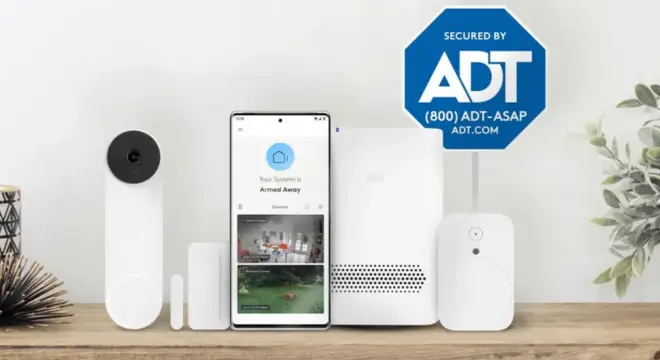ADT Security Hacked: What You Need to Know
Is Your Home Security Really Safe?
- What if the company protects your home… can’t even protect itself?
- Could hackers use stolen data to disable security systems?
- Is your personal information now at risk?
ADT is one of the top security companies in the country, which has now become the victim of a certain data theft situation. The system has been manipulated by intruders to intercept sensitive data, which led to the activation of alarms for several customers. As the case with ADT is not singular, it has encountered a few other lately, causing homeowners to wonder, “If ADT cannot secure its very own network, how can they ensure the security of my home?”
In this article, we’ll break down how the hack happened, what data was stolen, and—most importantly—what you can do right now to protect yourself. Stay with us, because this is something every ADT customer needs to know.
Breaking News: ADT Hacked Again! Is Your Data Safe?
Quick Summary of ADT’s Latest Security Failures:
- October 2024 Breach: Hackers gained access to ADT’s systems using stolen login credentials from a third-party vendor.
- August 2024 Breach: Cybercriminals stole customer and employee data and sold it on the dark web.
- Why Should You Be Concerned? If ADT—a home security giant—can’t protect its own systems, how can it keep your home safe?
Here’s What You Really Need to Know:
- ADT has been hacked multiple times, but what is the company actually doing to stop these attacks?
- Hackers are using the same tactics repeatedly—does this mean customer data could be stolen again?
- Is this just a data breach, or could your home security system be at risk too?
If you’re an ADT customer, it’s crucial to know whether your data—and your home—are truly secure. Let’s break it all down!
How Did Hackers Break Into ADT’s Systems?
ADT, a company trusted for home security, ironically fell victim to cybercriminals due to a combination of human error and weak security protocols. Let’s break down how hackers managed to breach ADT’s systems:
1. Third-Party Vendor Mistake – The Weakest Link
One of the biggest vulnerabilities in cybersecurity is third-party access—when companies allow external vendors or partners to connect to their internal systems. In ADT’s case, hackers exploited a third-party vendor’s stolen credentials to gain unauthorized access.
- Cybercriminals may have acquired these credentials through leakages, brute-force strategies, or phishing attacks targeted at the vendor employees.
- Since many companies fail to monitor third-party access closely, hackers were able to infiltrate ADT’s network without immediate detection.
This highlights a crucial issue: Even if ADT had strong security, a weak link in its supply chain was enough to let attackers in.
2. Phishing Attack – Employees May Have Been Tricked
Another possibility is that hackers used phishing tactics—fraudulent emails or fake login pages—to trick ADT employees into revealing their login credentials.
- A phishing attack is one of the most common ways hackers circumvent security systems.
- The careful construct of an email as being an “urgent security update” from ADT or its partners may have fooled its employees into entering their passwords into a false webpage.
- Once the hackers got into the employee’s account, they were free to enter deep into ADT’s internal network to extract sensitive data.
This raises concerns about whether ADT provided sufficient cybersecurity training to its employees to recognize such attacks.
3. Weak Security Practices – No Proper Authentication?
Strong cybersecurity requires multiple layers of protection. However, ADT failed to enforce key security measures that could have prevented this breach:
(i). No Multi-Factor Authentication (MFA):
- If ADT had mandatory two-factor authentication (2FA) for logins, stolen credentials alone wouldn’t have been enough to break in.
- MFA requires an additional verification step (like a phone code), which would have stopped unauthorized access.
(ii). Lack of Real-Time Monitoring:
- A company as big as ADT should have automated systems to detect suspicious logins—especially from unknown locations or devices.
- Had they monitored access logs more effectively, they might have caught the hackers earlier.
(iii). Poor Vendor Security Policies:
- ADT may not have imposed strict enough security controls on third-party vendors.
- If vendors were using weak passwords or outdated software, hackers could easily exploit those gaps.
What Data Was Stolen? Should You Be Worried?
A security breach is always worrying, but when it concerns a company that is in charge of protecting houses, the stakes are much more significant. ADT’s latest hack has provoked real fears about what data was taken and if the customers are in danger. Now uncover the details:
What’s at Risk?

1. Customer & Employee Data – Personal Information Exposed
One of the most alarming outcomes of this data breach is the possible compromise of personal information related to ADT customers and employees. Information possibly leaked includes:
- Full names
- Email addresses
- Phone numbers
- Home addresses (could lead criminals to knowledge of where these persons live)
- Payment details (printed full credit card information is admittedly not yet known)
This type of information can be used for identity theft, phishing scams, and social engineering attacks. Hackers could impersonate ADT representatives and con customers out of more sensitive information by leveraging stolen data against them.
2. Home Security Data – Are Your Alarms and Cameras Safe?
The major questions that ADT customers want answered are: Have the hackers accessed security system controls?
- This is of paramount relevance, for if one is able to obtain unauthorized access to alarm settings, camera feeds, and entry logs, then it gets into an even more troublesome matter of privacy and safety.
- ADT has not confirmed to what extent any security devices were involved or not.
However, if the hackers were capable of accessing the decrypted system data, they may disable alarms or note when people are not at home.
3. Encrypted vs. Unencrypted Data – Was It Properly Secured?
Not all stolen data is equally dangerous. Was the stolen sensitive data encrypted?
- Encrypted data: If the data was secured with strong encryption, the hackers will be limited by having to retrieve a decryption key to make sense of it-all that is, therefore, this will lead to little risk.
- Unencrypted Data: People will gain access to any main information with zero protection and had it used by hackers.
ADT has not specifically said whether or not all customer data was sufficiently encrypted, thus making it unclear regarding their exposure level.
Should You Be Worried?
Yes. Even if home security systems weren’t directly compromised, stolen personal information can still be used in dangerous ways:
- Phishing Scams: Hackers could pretend to be representatives of ADT in order to get their customers to divulge their passwords or security codes in an effort of social engineering.
- Targeted Burglaries: If criminals ever find out the timing with which people are home (or not) and/or get to know their addresses, this information could become the basis for real-world crimes.
- Identity Theft & Fraud: Leaked personal and financial information can open up accounts and possibly lead to victim fraud.
The Real Danger – Is Your Home at Risk?
When a security company like ADT is hacked, it raises a frightening question: Can hackers use this data to break into homes? While ADT has not confirmed whether its security systems were directly compromised, the stolen data could still pose serious risks to customers.
Let’s explore the potential dangers that could arise from this breach.
What Happens If Hackers Use This Data?
1. Can Hackers Disable ADT Alarms?
One of the biggest concerns is whether cybercriminals can bypass or disable ADT alarm systems. While there is no direct evidence that this has happened in the recent breach, past incidents show that smart security systems are not invincible.
- If hackers obtained system credentials or software access, they could potentially remotely disable alarms, leaving homes unprotected.
- Certain ADT systems rely on cloud-based controls, which means if hackers found a vulnerability, they could manipulate alarm settings from anywhere.
- Security footage access could allow criminals to see when homeowners are away, increasing the risk of targeted break-ins.
Even if hackers cannot directly disable alarms, they might sell stolen customer data on the dark web to criminals looking for vulnerable homes.
2. Scams & Fraud Risks – The Hidden Threat
Even if your alarm system remains intact, the stolen data can be used for fraud and scams.
- Phishing Attacks – Hackers might impersonate ADT and contact customers via email or phone, tricking them into revealing security codes or passwords.
- Fake ADT Technicians – Criminals could call or visit homes, posing as ADT employees, and convince homeowners to disable alarms or install fake software.
- Identity Theft – With enough personal data, hackers could open accounts, steal financial details, or conduct fraudulent transactions under victims’ names.
Real-World Example: In 2020, a former ADT technician illegally accessed customers’ home security cameras to spy on them. This shows that insider threats and weak security controls can put homeowners at risk.
3. ADT Customers Beware – Signs of Suspicious Activity
If you are an ADT customer, stay alert for these warning signs:
- Unexpected Calls from ADT – If someone claiming to be from ADT asks for login details, security codes, or payment information, be cautious.
- Strange Emails with Links – Phishing emails might try to get you to click on fake ADT websites and steal your login details.
- Random Security System Glitches – If your system starts acting strangely (e.g., alarms turning off unexpectedly), contact ADT immediately.
- Unusual Account Activity – Check your ADT account for any unauthorized login attempts or device changes.
How to Protect Yourself Right Now
If you’re an ADT customer, taking immediate action is the best way to protect your data, security system, and home. Since hackers have already breached ADT’s systems multiple times, you can’t rely on the company alone to keep you safe.
Here’s a step-by-step guide to securing your home and personal information.
Step-by-Step Guide to Securing Your Home Security System
1. Change Your ADT Password Immediately
Your first step should be updating your ADT account password to something strong and unique.
- Avoid using passwords that contain personal information (name, birthdate, address).
- Use a mix of uppercase, lowercase, numbers, and special characters (e.g., X7y!tP@3z9).
- Never reuse passwords from other accounts. If a hacker has your login from another breach, they might try it on ADT.
- Consider using a password manager to keep track of secure passwords.
2. Enable Two-Factor Authentication (2FA)
Two-Factor Authentication (2FA) adds an extra layer of security by requiring a second step (such as a text code or authentication app) before logging in.
- Even if hackers steal your password, they won’t be able to log in without the second factor.
- Use an authentication app (like Google Authenticator) instead of SMS, as phone numbers can be hijacked.
- ADT provides 2FA options—make sure it’s turned on in your account settings.
3. Check If Your Data Was Leaked
If ADT has been hacked, your personal data might already be on the dark web.
- Use sites like Have I Been Pwned to check if your email or password has been compromised.
- If your credentials were exposed, change your ADT and other important passwords immediately.
- Monitor your email for suspicious login alerts or security warnings.
4. Be Wary of Scams & Fake ADT Calls
Hackers may try to use stolen ADT customer information to trick you. Watch out for:
- Phishing Emails pretending to be from ADT, asking you to reset your password or provide account details.
- Fake Customer Support Calls asking for login credentials or security codes.
- Scammers Posing as ADT Technicians trying to access your home security settings or sell fake “security upgrades.”
How to stay safe:
- Never click on suspicious links in emails. Always go to the official ADT website.
- If ADT calls you, verify their identity by calling ADT directly at their official customer service number.
- Don’t share account credentials or security codes with anyone.
5. Consider Alternative Security Solutions
If ADT continues to suffer breaches, it may be time to explore other home security options.
- Compare security providers like SimpliSafe, Ring, and Vivint, which offer strong encryption and security updates.
- Look for systems that prioritize cybersecurity and have a strong track record of protecting customer data.
- Consider adding independent security measures like CCTV cameras, smart locks, or additional motion sensors separate from ADT.
Your home security should never rely on just one system. Using multiple security layers makes it harder for hackers to compromise everything at once.
ADT’s Response – Are They Doing Enough?
After multiple security breaches, ADT has responded with official statements and promises of security improvements. But are these measures truly effective, or just a way to control the damage? Let’s break it down.
What ADT Is Saying vs. What Experts Think
1. ADT’s Official Statement
ADT has acknowledged the breach, stating:
“We take security seriously and are actively investigating the breach. Protecting our customers remains our top priority.”
While this sounds reassuring, it lacks specifics—what exactly are they doing to prevent future attacks?
2. Security Fixes Promised
ADT has announced several measures to address security concerns, including:
- Enhanced cybersecurity protocols to detect and prevent unauthorized access.
- Stronger authentication measures for customer logins.
- Collaboration with cybersecurity experts to assess vulnerabilities.
However, there’s little transparency about whether these fixes are truly effective or just short-term solutions to regain customer trust.
3. Cybersecurity Experts Weigh In
While ADT claims they are improving security, some experts remain skeptical.
- Repeated Breaches: Since ADT has been hacked multiple times, is their security approach fundamentally flawed?
- Weak Third-Party Controls: If hackers got in through a third-party vendor, has ADT truly secured its external partnerships?
- PR vs. Real Action: Some believe ADT’s response is more about damage control than actual security improvements.
Cybersecurity professionals emphasize that true security requires constant monitoring and proactive defenses—not just fixes after a breach has already happened.
Expert Insights – What This Means for the Future of Home Security
The ADT security breach is not just about one company—it’s a wake-up call for the entire home security industry. If hackers can infiltrate a major security provider, what does this mean for the future of smart home protection?
1. The Bigger Picture
Security Companies Are a Prime Target
Hackers are increasingly targeting home security companies because:
- One breach = thousands of vulnerable homes.
- Home automation systems store valuable personal data.
- Many customers trust security companies blindly, assuming their data is safe.
If security companies fail to stay ahead of cyber threats, we may see more frequent and sophisticated attacks in the future.
2. What Other Companies Are Doing Better
While ADT struggles with security breaches, some competitors are taking extra steps to protect their customers:
- SimpliSafe – Uses end-to-end encryption to secure communications.
- Ring (Amazon-owned) – Offers advanced two-factor authentication and regular security patches.
- Vivint – Implements AI-driven security monitoring to detect threats before they happen.
These companies focus on stronger cybersecurity practices, showing that ADT must do more to stay competitive.
3. The Future of Home Security – Can It Ever Be Truly Hack-Proof?
As home security becomes more reliant on smart technology, cyber risks will continue to grow. Experts suggest:
- Companies need to adopt stronger encryption and zero-trust security models.
- Consumers should demand transparency and better security standards from home security providers.
- The government may introduce stricter regulations to ensure companies protect customer data.
While 100% hack-proof security may never exist, companies like ADT must continuously evolve or risk becoming a weak link in home safety.
FAQs (Frequently Asked Questions)
Q1: Can hackers disable ADT alarms or access cameras?
There is no confirmed evidence that hackers have directly accessed ADT home security devices, but the possibility exists. Weak passwords or system vulnerabilities could be exploited, so users should stay cautious.
Q2: What should I do if I’m an ADT customer?
Change your password, enable two-factor authentication (2FA), and monitor your account for any unusual activity. These steps help protect against unauthorized access and potential fraud.
Q3: Is ADT still a safe choice for home security?
ADT has strong security systems, but repeated breaches raise concerns. Customers should evaluate other options, such as SimpliSafe, Ring, and Vivint, which focus on encryption and advanced security features.
Q4: How can I check if my ADT account was affected?
ADT has not publicly disclosed affected accounts. Customers should check for security alerts, watch for phishing attempts, and monitor their account for any suspicious activity.
Conclusion – Should You Still Trust ADT?
No security company is completely safe from cyberattacks. Customers should take additional precautions instead of relying solely on ADT. Stronger cybersecurity measures, better awareness, and constant vigilance are essential for home security.
Is your smart home really secure? It may be time to reassess your security system.


